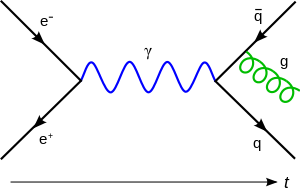Beta function (physics)
| Quantum field theory |
|---|
| History |
|
Incomplete theories |
|
Scientists
|
In theoretical physics, specifically quantum field theory, a beta function, β(g), encodes the dependence of a coupling parameter, g, on the energy scale, μ, of a given physical process described by quantum field theory. It is defined as
and, because of the underlying renormalization group, it has no explicit dependence on μ, so it only depends on μ implicitly through g. This dependence on the energy scale thus specified is known as the running of the coupling parameter, a fundamental feature of scale-dependence in quantum field theory, and its explicit computation is achievable through a variety of mathematical techniques.
Scale invariance
If the beta functions of a quantum field theory vanish, usually at particular values of the coupling parameters, then the theory is said to be scale-invariant. Almost all scale-invariant QFTs are also conformally invariant. The study of such theories is conformal field theory.
The coupling parameters of a quantum field theory can run even if the corresponding classical field theory is scale-invariant. In this case, the non-zero beta function tells us that the classical scale invariance is anomalous.
Examples
Beta functions are usually computed in some kind of approximation scheme. An example is perturbation theory, where one assumes that the coupling parameters are small. One can then make an expansion in powers of the coupling parameters and truncate the higher-order terms (also known as higher loop contributions, due to the number of loops in the corresponding Feynman graphs).
Here are some examples of beta functions computed in perturbation theory:
Quantum electrodynamics
The one-loop beta function in quantum electrodynamics (QED) is
or, equivalently,
written in terms of the fine structure constant, α = e2/4π .
This beta function tells us that the coupling increases with increasing energy scale, and QED becomes strongly coupled at high energy. In fact, the coupling apparently becomes infinite at some finite energy, resulting in a Landau pole. However, one cannot expect the perturbative beta function to give accurate results at strong coupling, and so it is likely that the Landau pole is an artifact of applying perturbation theory in a situation where it is no longer valid.
Quantum chromodynamics
The one-loop beta function in quantum chromodynamics with flavours is
or
written in terms of αs = .
If nf ≤ 16, the ensuing beta function dictates that the coupling decreases with increasing energy scale, a phenomenon known as asymptotic freedom. Conversely, the coupling increases with decreasing energy scale. This means that the coupling becomes large at low energies, and one can no longer rely on perturbation theory.
SU(N) Non-Abelian gauge theory
While the (Yang-Mills) gauge group of QCD is , and determines 3 colors, we can generalize to any number of colors, , with a gauge group . Then for this gauge group, with Dirac fermions in a representation of , the one-loop beta function is
where is the quadratic Casimir of and is another Casimir invariant defined by for generators of the Lie algebra in the representation R. For gauge fields (i.e. gluons) in the adjoint of , ; for fermions in the fundamental (or anti-fundamental) representation of , . Then for QCD, with , the above equation reduces to that listed for the quantum chromodynamics beta function.
This famous result was derived nearly simultaneously in 1973 by Politzer,[1] Gross and Wilczek,[2] and 't Hooft,[3] for which the first three were awarded the Nobel Prize in Physics in 2004.
Minimal Supersymmetric Standard Model
See also
References
- ↑ H.David Politzer (1973). "Reliable Perturbative Results for Strong Interactions?". Phys. Rev. Lett. 30: 1346–1349. Bibcode:1973PhRvL..30.1346P. doi:10.1103/PhysRevLett.30.1346.
- ↑ D.J. Gross and F. Wilczek (1973). "Asymptotically Free Gauge Theories. 1". Phys. Rev. D. 8: 3633–3652. Bibcode:1973PhRvD...8.3633G. doi:10.1103/PhysRevD.8.3633.
- ↑ G. 't Hooft (1973). Unpublished. Missing or empty
|title=(help)
Further reading
- Peskin, M and Schroeder, D.; An Introduction to Quantum Field Theory, Westview Press (1995). A standard introductory text, covering many topics in QFT including calculation of beta functions; see especially chapter 16.
- Weinberg, Steven; The Quantum Theory of Fields, (3 volumes) Cambridge University Press (1995). A monumental treatise on QFT.
- Zinn-Justin, Jean; Quantum Field Theory and Critical Phenomena, Oxford University Press (2002). Emphasis on the renormalization group and related topics.
